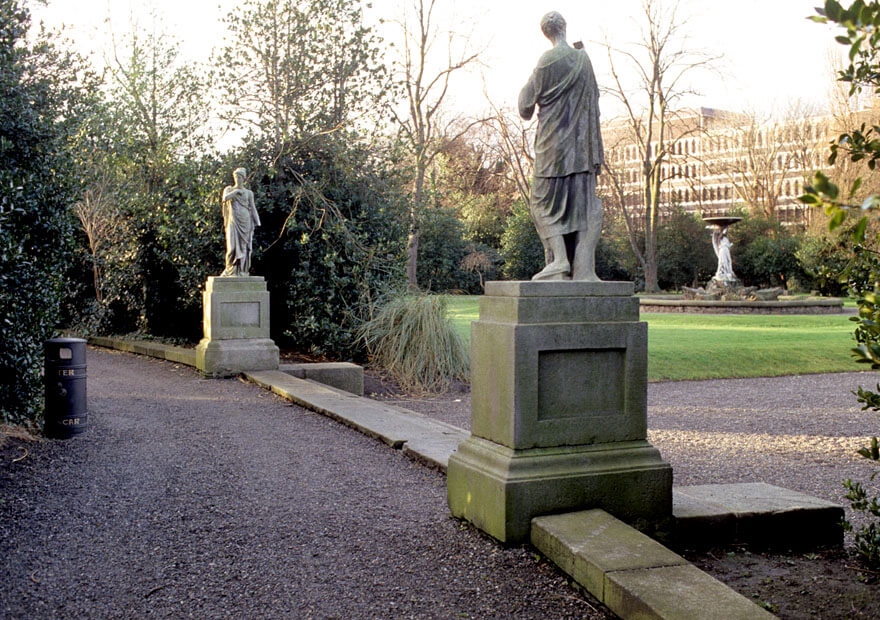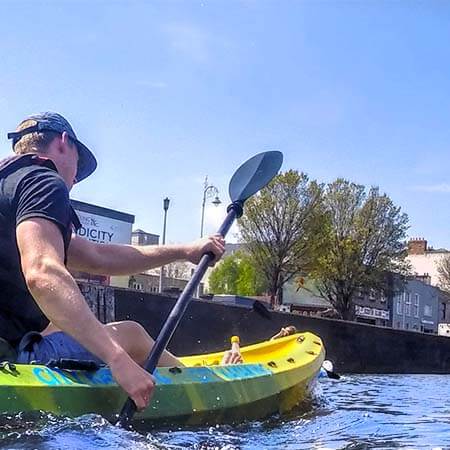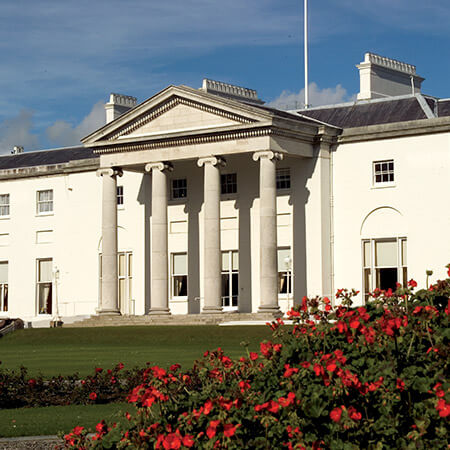If you’re seeking complete refuge from the clamour of the city, then head away from Stephen’s Green. Instead, walk up Harcourt Street. Take a left. And approach the gates at the end of Clonmel Street. Enter. Now, breathe.
Around you are green lawns. Trees. Fountains. Statues. A rose garden. A maze. A grotto. An elegant promenade. And, crucial to our purpose here, not very many people.
Indeed, mid-afternoon on an autumn’s day, you may very well have the place to yourself. The place is Iveagh Gardens. Like Stephen’s Green, it’s a Victorian park. But the difference in the atmosphere is pronounced – and this comes as a direct result of its history.
The creation of the Iveagh Gardens
As you go inside, there’s a large sunken lawn to the left. In 1865, the Iveagh Gardens was the venue for the Dublin Exhibition – an international fair that showcased the country’s fine art, textiles and manufactured goods.
Among the attractions on offer was an archery ground. Walk – or slip – down the steep slope that surrounds the lawn and you’re standing on it.
The lawn is five feet lower than the rest of the gardens for safety reasons. A novice Victorian archer, in her bonnet and crinolines, could not be trusted to hit her target every time. It was calculated that an arrow could do less damage when loosed on this sunken lawn.
Iveagh Gardens takes its name from Edward Guinness, aka Lord Iveagh. This Guinness was a grandson of the original Arthur Guinness – founder of the world-famous brewery at Saint James’ Gate. He and his elder brother – another Arthur – inherited the business, as well as an extremely fine house on Stephen’s Green, in 1868.
When Edward became Lord Iveagh, the house became Iveagh House and the exhibition grounds, which he had bought, became part of its garden.

Statues in Iveagh Gardens – images courtesy ©Fáilte Ireland ©Tourism Ireland
Royal pursuits and proper pronunciation
A note here on pronunciation: Dubliners pronounce ‘Iveagh’ Gardens as ‘ivy’ – excusable, perhaps, because ivy and gardens are associated. However, the fourth and current Lord Iveagh, who is also head of the Guinness family, pronounces his own name as ‘Ive-a’.
He lives in another of his great-grandfather’s old properties – the 22,486 acre Elveden Estate in Suffolk in the south of England. It seems that Elveden was purchased by the original Lord Iveagh largely because his friend King Edward loved shooting.
The King suggested that Iveagh should acquire an estate where he could indulge in this passion. And just outside the Earlsfort Terrace exit of the Iveagh Gardens in Dublin, there’s evidence of another kingly interest that was catered for.
What possible purpose could that enormous red-brick, barn-like building serve? It has no windows in the walls and a long skylight on the roof. Very strange.
Well, in 1890, this was the venue of the world real tennis championships. Not to be confused with the sport played at Wimbledon, real tennis is like a cross between lawn tennis and squash. It’s played on a court that resembles a medieval cloister.
Guinness had this one built in his back garden by one of his brewery engineers. It was finished just in time for the visit of the then Prince of Wales in 1885.
Opening hours at the Iveagh Gardens
At four o’clock, a gardener rings the handbell and ushers you out the gate. He says that when they hear the bell, the garden’s resident rooks and crows know the coast is clear. They fly down to the ground where they attempt to smash open tasty walnuts and chestnuts, dropped by the trees.
But the gardens don’t always close at this time. It all depends on the season. Though the gates open at 8am all year round (and at 10am on Sundays), they close at around 3.30pm from late November to January. Then at 4pm in early November and February. And then at 6pm from March through to October.
Great to be back in Iveagh Gardens today- a hidden gem in the centre of Dublin – check it out next time you visit pic.twitter.com/PjoNCqAGgv
— Karl Gardner (@karlgardnerirl) August 31, 2016
People exit back onto Clonmel Street, as well as through gates at the back of the National Concert Hall and onto Hatch Street to the south of the park.
As you head back toward the city centre, look back at the concert hall building. There are plans for it to house Ireland’s first national science centre, which will include a new planetarium that opens out onto the gardens. If you’re fond of the cosmic swirl in a pint of Guinness as it settles, this seems apt.
For more information on the gardens, head to OPW’s website. Or check out our guide to Dublin’s parks if you’d like to explore more of the city’s greenery.



